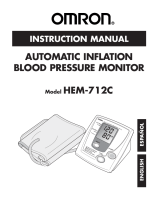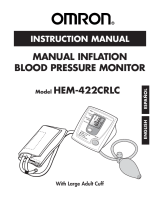GARANTÍA LIMITADA
E42
Su monitor de presión arterial automático serie 7 BP760 de Omron
®
, excluyendo el
brazalete, está garantizado como libre de defectos en materiales y mano de obra que
se presenten dentro de los 5 años de la fecha de compra, si se usa de acuerdo con las
instrucciones proporcionadas con su monitor. El brazalete está garantizado como libre
de defectos en materiales y mano de obra que se presenten dentro de un año de la fecha
de compra, si el monitor se usa de acuerdo con las instrucciones proporcionadas con su
monitor. Las garantías arriba mencionadas se extienden únicamente al comprador original.
A consideración nuestra, repararemos o reemplazaremos, sin costo alguno, cualquier
monitor o brazalete cubierto por la garantía. La reparación o el reemplazo son nuestra
única responsabilidad y su único recurso bajo la garantía provista.
Para recibir el servicio de garantía, póngase en contacto con el servicio de atención al cliente,
llamando al 1-800-634-4350 para averiguar la dirección donde se realizan las reparaciones y
las tarifas de envío por devolución.
Adjunte el comprobante de compra. Incluya una carta con su nombre, dirección,
número de teléfono y la descripción del problema específico. Empaquete el
producto cuidadosamente para evitar que se dañe durante el traslado. Dado que
existe la posibilidad de pérdida durante el traslado, le recomendamos que asegure
el producto con solicitud de acuse de recibo.
LA GARANTÍA ANTES MENCIONADA ES LA ÚNICA GARANTÍA
PROVISTA POR OMRON EN RELACIÓN A ESTE PRODUCTO,
Y POR MEDIO DE LA PRESENTE OMRON NIEGA CUALQUIER
OTRA GARANTÍA, EXPLÍCITA O IMPLÍCITA, INCLUYENDO LAS
GARANTÍAS IMPLÍCITAS DE COMERCIABILIDAD Y APTITUD
PARA PROPÓSITOS PARTICULARES. LAS GARANTÍAS IMPLÍCITAS
Y OTROS TÉRMINOS IMPUESTOS POR LEY, SI EXISTIERAN, SE
LIMITAN AL PERIODO DE DURACIÓN DE LA GARANTÍA EXPRESA.
OMRON NO ES RESPONSABLE POR LA PÉRDIDA DE USO, NI POR
NINGÚN OTRO COSTO, GASTO O DAÑO ESPECIAL, FORTUITO,
CONSECUENTE O INDIRECTO.
Esta garantía le proporciona derechos legales específicos y usted puede tener otros
derechos que varíen por jurisdicción. Debido a especiales requisitos locales, es posible
que algunas de las limitaciones y exclusiones antes mencionadas no apliquen a su caso.
SERVICIO DE ATENCIÓN AL CLIENTE
Visite nuestro sitio Web en: www.omronhealthcare.com
Llame sin cargo al: 1-800-634-4350




























































































